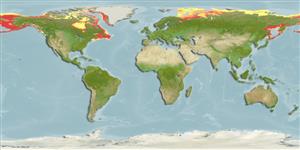>
Perciformes/Zoarcoidei (Eelpouts and pricklebacks) >
Lumpenidae (Eel pricklebacks)
Etymology: Lumpenus: Latin, lumpus, an uncouthlooking spiny-finned fish of a leaden-blue colour (Ref. 45335).
Environment: milieu / climate zone / depth range / distribution range
Οικολογία
Θαλασσινό(ά) βενθικό(ς); εύρος βάθους 0 - 235 m (Ref. 50610). Polar; 82°N - 42°N, 33°E - 43°W
Circumpolar. Arctic, North Pacific and Northwest Atlantic: Barents Sea eastward to western Greenland; in the Pacific to southeastern Alaska and to northern Sea of Okhotsk; in western Atlantic to Nova Scotia.
Μέγεθος / Βάρος / Age
Maturity: Lm ? range ? - ? cm
Max length : 36.5 cm NG αρσενικό/απροσδιόριστο; (Ref. 58426)
Inhabits sandy to rocky bottoms, often in seagrass or algae; rarely, if ever, found in intertidal area (Ref. 51666). Feeds on crustaceans, worms, clams, and fish eggs (Ref. 58426).
Life cycle and mating behavior
Maturities | Αναπαραγωγή | Spawnings | Egg(s) | Fecundities | Προνύμφες
Robins, C.R. and G.C. Ray, 1986. A field guide to Atlantic coast fishes of North America. Houghton Mifflin Company, Boston, U.S.A. 354 p. (Ref. 7251)
IUCN Red List Status (Ref. 130435)
Threat to humans
Harmless
Human uses
Εργαλεία
Special reports
Download XML
Διαδικτυακές πηγές
Estimates based on models
Preferred temperature (Ref.
123201): -1.6 - 3.8, mean -0.3 °C (based on 2023 cells).
Phylogenetic diversity index (Ref.
82804): PD
50 = 0.6250 [Uniqueness, from 0.5 = low to 2.0 = high].
Bayesian length-weight: a=0.00398 (0.00239 - 0.00663), b=2.80 (2.66 - 2.94), in cm total length, based on LWR estimates for this species & (Sub)family-body (Ref.
93245).
Τροφικό Επίπεδο (Ref.
69278): 3.3 ±0.37 se; based on food items.
Ελαστικότητα (Ref.
120179): Μεσαίο(α), ελάχιστος χρόνος για διπλασιασμό πληθυσμού 1,4 - 4,4 έτη (Preliminary K or Fecundity.).
Fishing Vulnerability (Ref.
59153): Moderate vulnerability (40 of 100).
